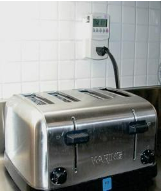Power Testing with a Kill-A-Watt Monitor

Overview
The model P4460 Kill-A-Watt power meter is a device used to monitor power use of household plugs and appliances. The Kill-A-Watt power monitor allows:
- Measurement of real time line voltage (Volts), current (amps), power (Watts), apparent power (VA), frequency (Hz), and power factor (PF).
- Recording of cumulative energy consumption (kWh-kilowatt hours) over a period of time.
- This meter does not require a computer interface.
NOTE: The Kill-a-Watt meter must be plugged into a receptacle to operate. Data is stored on the device so it can be unplugged, however write down results as soon as possible to avoid data loss.

Monitoring Plug Loads
- Plug the Kill-A-Watt into an outlet. The monitor must be plugged into a receptacle to operate and display values.
- Reset the Kill-A-Watt monitor:
- Press and hold the RESET button under the display until “rESt” is displayed.
- Press the Menu button until “Volt” is shown on right side of the display.
- Press the Up or Down buttons until Watts is displayed.
- Plug the equipment into the receptacle on front of the Kill-A-Watt.
- Turn the equipment on to the desired setting, use the equipment as intended.*
- Observe the readings for the first 30 seconds and note the highest number displayed. Record this value.
- Observe the reading again, once it has settled to a consistent number. Record this value.
- Use the equipment as intended or for a minimum of 15 minutes or as you normally would.
- Use the Up or Down buttons until Amps is displayed. Record this value.
- Unplug the equipment from the Kill-A-Watt monitor.
- Press the Up or Down buttons until kWH is displayed. Record this value.
Information Required When Testing
- Manufacturer, Model Number and Serial Number
- Photo of the device
- Settings Used
- Demographics:
- Approximate Elevation
- Age and approximate weight of the user
- Responsible Party – Number on the Kill-A-Watt device
- Duration of the Test - Start and Stop Times
- Ask the tester how many days/week and hours/day the equipment is used
- Age of the device (if known)
- Was the equipment used as intended during the test or simply run unused. E.g. CPAP mask worn versus unworn during the test period.
List of Potential Equipment to be Tested
- Aerosol Tent
- Air Mattress/Hospital Bed
- Apnea Monitor
- Automatic Door Openers
- Breather Machine (IPPB)
- Ceiling Lift
- Chair Lift
- Communication Device
- Compressor/Concentrator
- CPAP/BiPAP Machine
- Defibrillator
- Dialysis Machine
- Electronic Nerve Stimulator
- Electrostatic Nebulizer
- Elevator/Stair Lift
- Equipment Monitor
- Heating or Cooling System for body temperature regulation
- Hearing Aid Charger
- Hemodialysis Machine
- Infusion Pump
- Inhalation Pulmonary Pressure
- Left Ventricular Assist Device (LVAD)
- Motorized Wheelchair
- Oxygen Generator
- Power Scooter
- Pressure Pad
- Pressure Pump
- Pulse Oximeter/Monitor
- Refrigerated Medication (i.e. insulin)
- Respirator (all types)
- Suction Machine
- Total Artificial Heart (TAH-t)
- Ultrasonic Nebulizer
- Ventilators
- Vest/Airway Clearance System
- Wound Care Management
Center for Inclusive Design and Engineering (CIDE)
CU Denver
The Hub, Bioengineering
1224 5th Street
Suite 130
Denver, CO 80204
303-315-1280
CMS Login